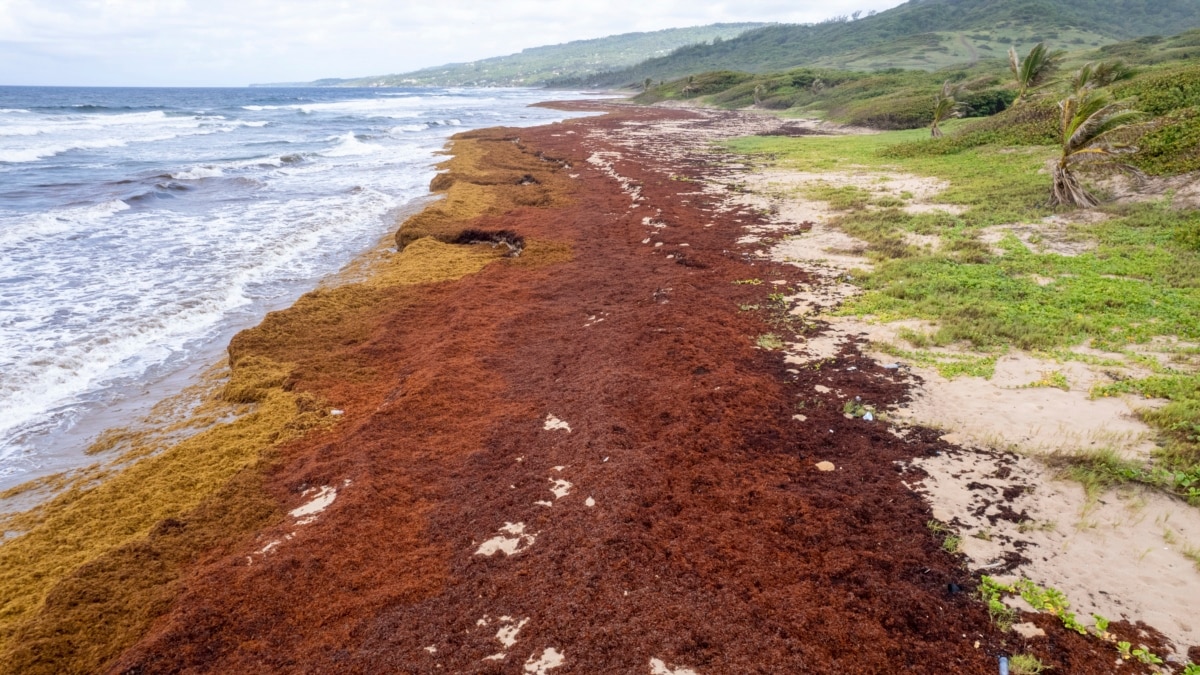Almost record amounts of seaweed are choking the Caribbean coasts stretching from Puerto Rico to Barbados. Due to the seaweeds the wildlife of this region is destroyed, tourism is stifled and noxious gases are hovering across the region.
More than 24 million tons of sargassum covered the Atlantic earlier in June breaking an all-time record set in 2018 by 20%.
The data is recorded according to the survey made by the University of South Florida’s Optical Oceanography Lab. It also reveals that massive quantities of brown algae drifted into the Caribbean Coast.
Recently, an uninhabited island near the French Caribbean territory of St. Martin was found covered by a blanket of tattered vegetation. The place is popular with tourists.
The sight of such litter forced officials to suspend ferry service and cancel kayaking, paddle boarding and snorkeling tours. The clear waters around Pinel Island turned into a prickly yellowish brown slush.
An owner of the Caribbean Paddling said that he had to incur a loss of at least 10,000 USD and had to close his business on July 22.
According to scientists, more research is needed to delve deep into the cause behind the rise of sargassum levels.
But, the United Nations’ Caribbean Environment Program ascertained that the possible factors include a rise in water temperatures as a result of climatic change and nitrogen laden fertilizer and sewage that nourish the algae.
A university researcher said that huge masses of seaweed have severe impact in the environmental changes that result in change in water temperature and Ph balance and reduction in corals, seagrass and sponges.
Due to the massive concentration of algae in parts of eastern Caribbean, the French island of Guadeloupe issued a heath alert in late July.
It warned some communities about high levels of hydrogen sulfide gas (smells like rotten eggs) released from the clumped of rotten seaweed. This gas can affect people with asthma.
The Biden administration also declared a deferral emergency after the US Virgin Islands warned last month about a desalination plant near St. Croix which is struggling to produce water and meet demand due to high amount of sargassum clogging.
Added to that, the Virgin Island’s electricity generating station depends on ultra pure water from desalination plant to reduce emissions. Officials said that such water loss would compel the government to use an expensive diesel fuel and that too in limited supply.
The sargassum levels for eastern Caribbean were close to a record level this year which is second only to what was recorded in the year in 2018. The levels in the north Caribbean stand at the third position.
Experts first noticed the presence of sargassum in the Caribbean Sea in 2011 an practically since then the problem has started developing every year.
The presence of sargassum in moderation helps in purification of water and absorption of carbon dioxide. It is a key component for building a healthy habitat for turtles, fishes, turtles, shrimps, crabs and other marine creatures.
It is also largely used in making fertilizers, bio-fuel, construction materials and medicinal components. But, it is not a very tourism friendly component when accumulates off the shores and the beaches.
According to the personal experience of the general manager of a tour company in the Dutch Territory if St. Maarten, this was certainly the worst they have ever seen. It also ruined his plans for personal beach trips.
Large masses of the sargassum have also strangled the fishing industry of the Caribbean Islands. Damaging the boat engines, fishing gear, preventing the fishermen from reaching their vessels and fishing grounds and causing a drop in the number of fishes caught are some of the hazards caused due to accumulation of sargassum.
This phenomenon has in particular affected the beaches of Barbados. The beaches there are piled with reddish brown seaweed.
There has been an instance of several deaths of fishes in the French Caribbean island in the Martinique which is supposedly caused due to an over abundance of sargassum. There are activists who are concerned about the plights of the endangered turtles.
Some are dying in the sea, entangled in the seaweed or are unable to lay eggs because of the layer of algae over the sand.
A trial program was carried out in the Cayman Islands in which crews pumped more than 2,880 sq ft of seaweed out of the water. But, later on Tuesday the government said that they have suspended the project.
This is because the seaweed has decomposed so much that it rendered the pumping useless.
As some nations use heavy machinery to remove weeds from the beach, scientists warn that too much use of such machineries can cause erosion and destroy the habitat of endangered turtles.
However, many Caribbean islands are struggling economically and do not have the means to clear the debris of the seaweeds.
So, the authorities are trying to find local funds to clean the beaches although a lot of things demand more funds right now.
Tags: Barbados, Cayman Islands, Puerto Rico, Caribbean Islands
